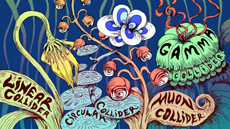Have a safe day!
Wednesday, Nov. 21
3:30 p.m.
DIRECTOR'S COFFEE BREAK - 2nd Flr X-Over
THERE WILL BE NO FERMILAB COLLOQUIUM THIS WEEK
Thursday, Nov. 22
Happy Thanksgiving!
Laboratory closed for holiday
Friday, Nov. 23
Laboratory closed for Thanksgiving holiday
Monday, Nov. 26
2:30 p.m.
Particle Astrophysics Seminar - Curia II
Speaker: David Bennett, Notre Dame University
Title: Most Planets are Cold and Lonely: The Latest Results from Gravitational Microlensing
3:30 p.m.
DIRECTOR'S COFFEE BREAK - 2nd Flr X-Over
THERE WILL BE NO ALL EXPERIMENTERS' MEETING THIS WEEK
Click here for NALCAL,
a weekly calendar with links to additional information.
Ongoing and upcoming conferences at Fermilab
|
|
Wednesday, Nov. 21
- Breakfast: breakfast casserole
- Golden broccoli and cheddar
- Chicken cordon bleu sandwich
- Country fried steak
- Smart cuisine: beef bourguignon
- Turkey bacon Swiss panini
- Assorted calzones
- Blackened chicken alfredo
Wilson Hall Cafe Menu |
|
Wednesday, Nov. 21
Lunch
- Cheese fondue
- Mixed-green salad
- Cold lemon soufflé
Friday, Nov. 23
Dinner
Closed
Chez Leon Menu
Call x3524 to make your reservation.
|
|
Happy Thanksgiving
 |
Julie Kurnat, Technical Division, drew this chalk drawing for the enjoyment of the Designing and Drafting Department. It is on display in the common area in Trailer 157, directly behind ICB.
|
|
A bouquet of options: Higgs factory ideas bloom
 |
Now that a Higgs-like boson has been discovered at the Large Hadron Collider, proposals to build colliders that churn out the new particle are gathering momentum. Image: Sandbox Studio
|
If you hurl two oranges together at close to the speed of light, there's going to be a lot of pulp. But, somewhere in the gooey mess will be the rare splinters left over from two seeds colliding.
The Large Hadron Collider at CERN works in a similar way. Protons, each made of quarks and gluons, collide and produce other particles. Roughly once every 5 billion proton collisions, everything aligns and a Higgs-like boson pops out.
It's a messy and inexact process. But that messiness gives scientists a way to observe a broad range of physics. Because all that pulp and the occasional seed collide in a different way almost every time, a huge array of particles can appear.
"It's a broadband machine," says Lyn Evans, the former director of the LHC. "Wherever the Higgs is, it will pop out, out of the noise."
Now that a boson with Higgs-like qualities has been found, physicists are calling for something more precise: a Higgs factory that would collide elementary particles to produce Higgs bosons in droves without all the distracting pulp. By colliding particles that don't break down into composite parts as they produce Higgs-like particles, a Higgs factory could allow a more precise view of the new boson.
Read more
—Signe Brewster
|
The Ohio State University
NAME:
The Ohio State University
HOME TOWN:
Columbus, Ohio
MASCOT:
Buckeyes
COLORS:
Scarlet and gray
COLLABORATING AT FERMILAB SINCE:
1970s
WORLDWIDE PARTICLE PHYSICS COLLABORATIONS:
ANITA (Antarctica), ATLAS (CERN), CDF, CMS, DES, Fermi Gamma-Ray Space Telescope (NASA), Pierre Auger
NUMBER OF SCIENTISTS AND STUDENTS INVOLVED:
15 faculty, 20 postdocs, 25 graduate students
PARTICLE PHYSICS RESEARCH FOCUS:
Experimental focuses are collider physics, dark energy, dark matter, cosmic rays and ultra-high-energy neutrinos. Theoretical focuses are BSM (supersymmetry), string theory, heavy quarks and lattice QCD.
WHAT SETS PARTICLE PHYSICS AT THE OHIO STATE UNIVERSITY APART?
We are unique in participating in three of the four major experiments at the Large Hadron Collider (CMS, ATLAS and ALICE). Also, our Center of Cosmology and Astro-Particle Physics (CCAPP) allows for interaction between the increasingly related fields of particle physics, astrophysics and cosmology.
FUNDING AGENCIES:
DOE, NSF, NASA
View all university profiles.
|
Particle physics research: impact and applications
From ISTC Catalyst, November 2012
Editor's note: Bob Kephart, Director of the Illinois Accelerator Research Center, wrote this article.
More than 30,000 particle accelerators are in operation worldwide. Unseen by most of us they quietly implant ions in the microchips of cell phones and computers, destroy cancer tumors, create medical isotopes, fabricate car and airplane components, develop new drugs, and discover the secrets of the universe.
Fermi National Accelerator Laboratory is America's premier national laboratory for the development, construction and operation of particle accelerators. Our seven particle accelerators—the largest of which is two miles around—drive scientists' exploration of the nature of matter, energy, space and time.
Read more
|
|
100-gigabit Ethernet technology coming to Fermilab
 |
|
Jon Bakken
|
Jon Bakken, head of the Core Computing Division, wrote this column.
Upgrades are coming to Fermilab's network capabilities. The upgrades will substantially increase the laboratory's off-site bandwidth capacity. Perhaps just as significantly, the upgrades will keep the laboratory's wide-area network infrastructure on the leading edge of network technology. To put things into perspective, after the upgrade our bandwidth will allow us to stream about 25,000 HD Netflix movies simultaneously—but we of course don't do that. We have better things planned.
Today, off-site network connectivity is provided through a metropolitan-area network (MAN) called ChiMAN. ChiMAN is an optical network infrastructure based on 10-gigabit Ethernet (10GE) technology and has been in place at the laboratory since 2006. ChiMAN currently provides eight 10GE channels to the laboratory for an aggregate of 80 gigabit-per-second off-site capacity. Two of these 10GE channels are dedicated for general user traffic such as the use of Web, e-mail and collaborative tools. Five 10GE channels are allocated for high-impact scientific data movement such as LHC CMS data. The remaining 10GE channel is used for network-related R&D activities.
ESnet, the laboratory's Internet service provider, is in the process of rolling out its latest network, ESnet5. ESnet5 is based on an advanced network infrastructure that includes 100-gigabit Ethernet (100GE) technology. Part of ESnet5 will be a new Chicago-area MAN, called ChiExpress, which will replace ChiMAN. The initial configuration of ChiExpress will provide the laboratory with one 100GE channel and three 10GE channels for an aggregate of 130 gigabit-per-second off-site capacity. The 100GE channel will be allocated primarily for moving high-impact scientific data, which makes up 95 percent of the laboratory's off-site network traffic. The excess capacity on that channel will be made available for various network, middleware and application R&D activities. The ChiExpress 10GE channels will be dedicated to general user traffic, in a fashion similar to ChiMAN today.
The initial 100GE deployment at Fermilab will be a router to support the ChiExpress 100GE channel. Internal production network 100GE infrastructure should follow in the coming years as the technology becomes available on a wider and less expensive spectrum of network platforms.
|
Main Ring Road closed next week
Main Ring Road will be closed between the AZero Service Building and F-4 Service Building from Monday, Nov. 26, at 7 a.m. to Friday, Nov. 30, at 3:30 p.m. The detour for accessing the AZero parking lot will be counterclockwise from the intersection at Main Ring Road and Booster Road.
|
ES&H weekly report, Nov. 20
This week's safety report, compiled by the Fermilab ES&H section, contains two incidents.
An employee suffered minor abrasions and bruising after falling down three steps. She received first-aid treatment.
An employee noted back pain while moving rocks and concrete. This case is currently under investigation and categorized as a pending claim.
Find the full report here. |
Obituary: Robert E. Shafer June 2, 1936–Nov. 11, 2012
From the Los Alamos Daily Post, Nov. 11, 2012
Editor's note: Robert Shafer, a world-class expert in beam instrumentation for particle accelerators, worked at Fermilab from 1969-1986. He is largely responsible for the Chipmunk and Scarecrow radiation monitoring devices widely used in Fermilab radiation protection systems. He also led the system design efforts for the Tevatron beam loss and position monitors and contributed to beam instrumentation developments at many other accelerator facilities.
Robert E. Shafer died suddenly at his home Sunday, Nov. 11, 2012. Born in Berkeley, Calif., June 2, 1936, he was 76 years old.
He is survived by his wife Ann Shafer, his sister Gretchen Simpkins, and his beloved Scottish terrier Rosie. He was preceded in death by his brother Paul and by his parents Margaret Shafer and Eugene Shafer.
Robert Shafer was a recognized expert in beam instrumentation for charged-particle accelerators. He is best known for his world-class expertise on Beam Position Monitors.
Read more
|
|